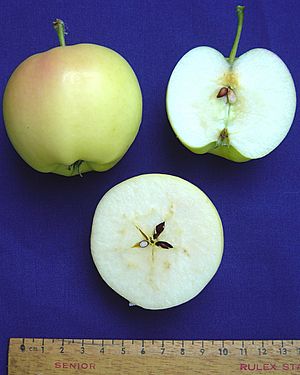PRI disease resistant apple breeding program facts for kids
The PRI disease resistant apple breeding program is a special team effort. It brings together experts from Purdue University, Rutgers University, and the University of Illinois. Their main goal is to create new types of apples, called cultivars, that can naturally fight off a common plant disease. This disease is known as apple scab. The name PRI comes from the first letter of each university: Purdue, Rutgers, and Illinois.
How the PRI Program Started
The idea for the PRI program began with a student named L. Fredric Hough. He was studying at the University of Illinois. Hough looked at old research from the early 1900s by C. S. Crandall. Crandall had studied how to make apples resistant to scab. He did this by crossing regular apples with crab apples.
Sadly, Crandall's work was not fully used at the time. If Hough had not found his research, it might have been lost forever. Hough published his own paper in 1944. This led to a partnership in 1945 with another scientist, J. Ralph Shay.
Later, Hough moved to Rutgers University. This helped the project grow even bigger. The collaboration then included all three universities.
How New Apples Are Bred
The PRI program uses a special method to create new apple types. It's called a backcross breeding strategy. Imagine you have a wild apple that is very good at resisting diseases. You also have a delicious apple that people love to eat.
Scientists take the disease-resistant genes from the wild apple. They then cross it with the tasty apple. This helps to pass on the good resistance. They keep doing this over many generations. Each time, they select the best apples. Their goal is to get apples that are both tasty and strong against diseases.
They looked at many different types of wild Malus (the scientific name for apple trees). They found the ones with the best resistance. Then, they carefully added these resistance traits into popular apple varieties.
Successes of the Program
The PRI program has been very successful. By the year 2000, they had already released eighteen new apple cultivars. All of these apples have a special gene called the Vf gene. This gene helps them resist apple scab. This important gene came from a wild apple tree called Malus floribunda 821.
The program has also shared more than fifty different types of apple genetic material. This material is called germplasm. It has been shared with scientists all over the world. This helps other breeders create even more disease-resistant apples.
See also
- Applecrab
- Pristine apple
- Enterprise (apple)
- Prima apple


